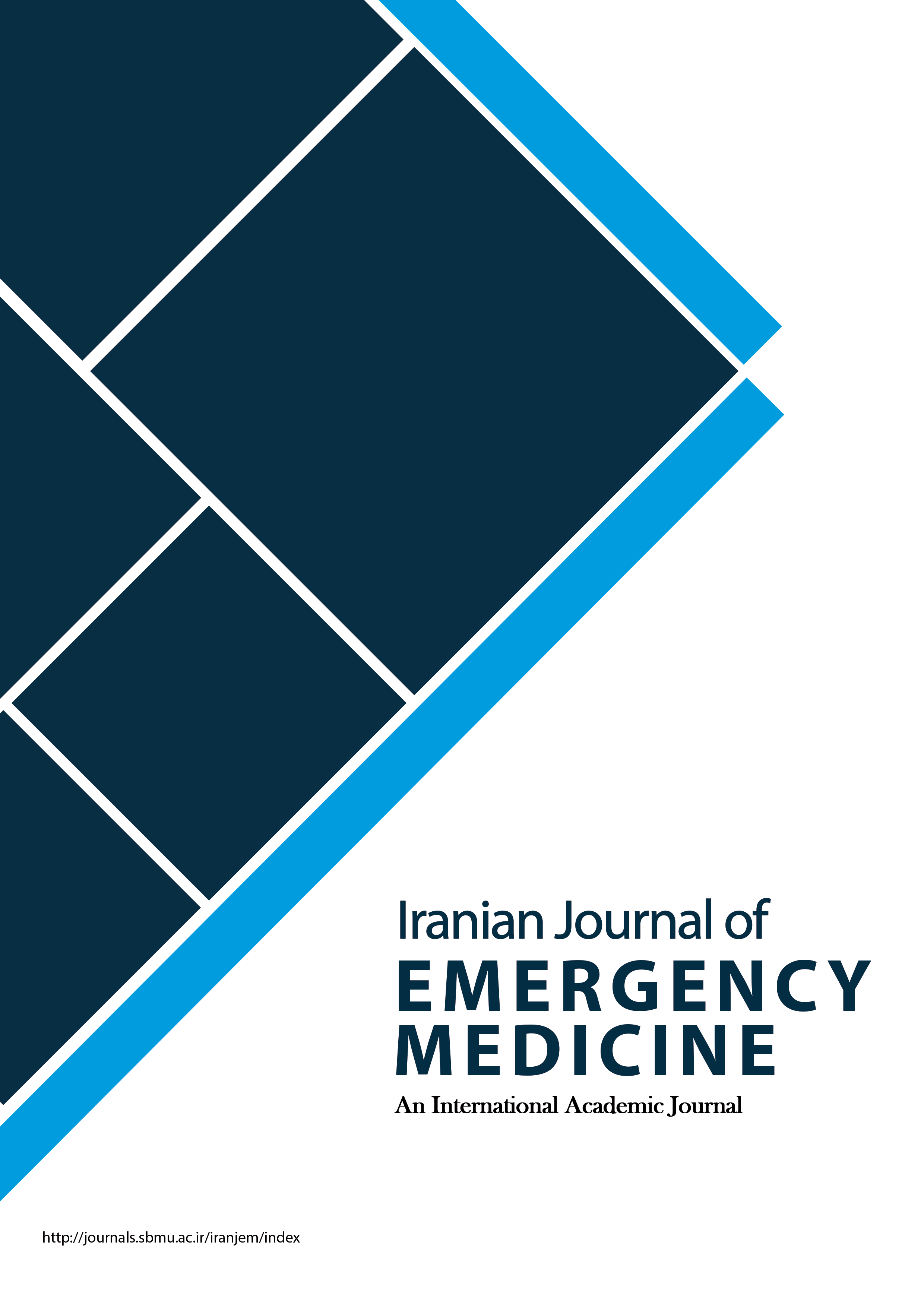Comparison of Kocher and Modified Hippocratic Methods in Reduction of Anterior Shoulder Dislocation; a Quasi Experimental Study
Iranian Journal of Emergency Medicine,
Vol. 4 No. 4 (2017),
8 October 2017
,
Page 168-164
https://doi.org/10.22037/ijem.v2i1.17601
Abstract
Introduction: Various methods have been designed for shoulder reduction and Kocher method (flexion, adduction and external rotation) and traction counter-traction are introduced as the oldest methods. Therefore, the present study was designed aiming to compare these two methods in reduction of anterior shoulder dislocation. Methods: This quasi experimental study was conducted on 16 to 60 year-old patients presenting to emergency department following anterior shoulder dislocation during 1 year. Patients underwent reduction via Kocher or traction counter-traction methods and were compared regarding reduction time, pain relief rate, success rate and neurological vascular complications. Results: 150 patients with the mean age of 32.11 ± 11.3 years were randomly divided into 2 groups of traction counter-traction (67 individuals) and Kocher (83 individuals) (86.7% male). The 2 groups were similar regarding age (p = 0.52) and sex (p = 0.679). There was no significant difference regarding pain relief after reduction between the 2 groups (p > 0.05). Mean reduction time was 72.27 ± 15.08 seconds in the traction group and 62.34 ± 24.35 seconds in the rotation group (p < 0.0001). In addition, duration of hospitalization was 3.00 ± 0.48 hours in traction group versus 3.08 ± 0.61 hours in the other group (p = 0.382). The frequency of failure in reduction cases was 1 (1.49%) in the traction group and 6 (7.22%) in the rotation group (p = 0.129). Finally, 2 (2.40%) cases of mild injury of brachial plexus in the ulnar nerve path occurred in the rotation group and no neurological complication was seen in the traction group. Conclusion: According to the results of the present study, Kocher and traction counter-traction methods were similar regarding pain relief after reduction and total duration of hospitalization, but reduction time was shorter in Kocher method and treatment failure rate was reported to be higher in this method.- دررفتگی شانه؛ ترکشن؛ روتیشن؛ جااندازی؛ تروما
How to Cite
References
Zacchilli MA, Owens BD. Epidemiology of shoulder dislocations presenting to emergency departments in the United States. The Journal of Bone & Joint Surgery. 2010;92(3):542-9.
Mirick MJ, Clinton JE, Ruiz E. External rotation method of shoulder dislocation reduction. Journal of the American College of Emergency Physicians. 1979;8(12):528-31.
Eachempati KK, Dua A, Malhotra R, Bhan S, Bera JR. The external rotation method for reduction of acute anterior dislocations and fracture-dislocations of the shoulder. J Bone Joint Surg Am. 2004;86(11):2431-4.
Beattie T, Steedman D, McGowan A, Robertson C. A comparison of the Milch and Kocher techniques for acute anterior dislocation of the shoulder. Injury. 1986;17(5):349-52.
Manes HR. A new method of shoulder reduction in the elderly. Clinical orthopaedics and related research. 1980;147:200-2.
Matsen F, Arntz C, Lippitt S, Rockwood C. Rotator cuff. The shoulder. 1998;2:755-839.
Robinson CM, Kelly M, Wakefield AE. Redislocation of the shoulder during the first six weeks after a primary anterior dislocation: risk factors and results of treatment. J Bone Joint Surg Am. 2002;84-a(9):1552-9.
Baykal B, Sener S, Turkan H. Scapular manipulation technique for reduction of traumatic anterior shoulder dislocations: experiences of an academic emergency department. Emergency medicine journal. 2005;22(5):336-8.
Cunningham NJ. Techniques for reduction of anteroinferior shoulder dislocation. Emergency Medicine Australasia. 2005;17(5‐6):463-71.
Boger D, Sipsey J, Anderson G. New traction devices to aid reduction of shoulder dislocations. Annals of emergency medicine. 1984;13(6):423-5.
Gul M, Yavuz U, Sokucu S, Cetinkaya E, Arikan Y, Kabukcuoglu YS. Flexion-adduction-external rotation method for shoulder dislocations. Acta orthopaedica et traumatologica turcica. 2014;48(2):164-8.
Alimohammadi H, Azizi M-R, Safari S, Amini A, Kariman H, Hatamabadi HR. Axillary nerve block in comparison with intravenous midazolam/fentanyl for painless reduction of upper extremity fractures. Acta Medica Iranica. 2014;52(2):122-4.
Chung C. Closed reduction techniques for acute anterior shoulder dislocation: from Egyptians to Australians. Hong Kong J Emerg Med. 2004;11(3):178-88.
Janecki CJ, G HOSSAIN S. The forward elevation maneuver for reduction of anterior dislocations of the shoulder. Clinical orthopaedics and related research. 1982;164:177-80.
Milch H. Treatment of dislocation of the shoulder. Surgery. 1938;3(5):732-40.
Stimson L. An easy method of reducing dislocations of the shoulder and hip. Med Record. 1900;57:356-7.
Ghane M-R, Hoseini S-H, Javadzadeh H-R, Mahmoudi S, Saburi A. Comparison between traction-countertraction and modified scapular manipulation for reduction of shoulder dislocation. Chinese Journal of Traumatology. 2014;17(2):93-8.
Singh S, Yong CK, Mariapan S. Closed reduction techniques in acute anterior shoulder dislocation: modified Milch technique compared with traction-countertraction technique. Journal of shoulder and elbow surgery. 2012;21(12):1706-11.
Sontyana J, Gandharva GP, Jonnalagedda S, Shandilya SM, Thota K, Kumar KP. Flexion Adduction External Rotation (FADER) method for reduction of anterior shoulder dislocation: a study of 30 cases. Indian Journal of Orthopaedics Surgery. 2015;1(2):93-7.
- Abstract Viewed: 765 times
- PDF (فارسی) Downloaded: 242 times
- HTML (فارسی) Downloaded: 106 times



